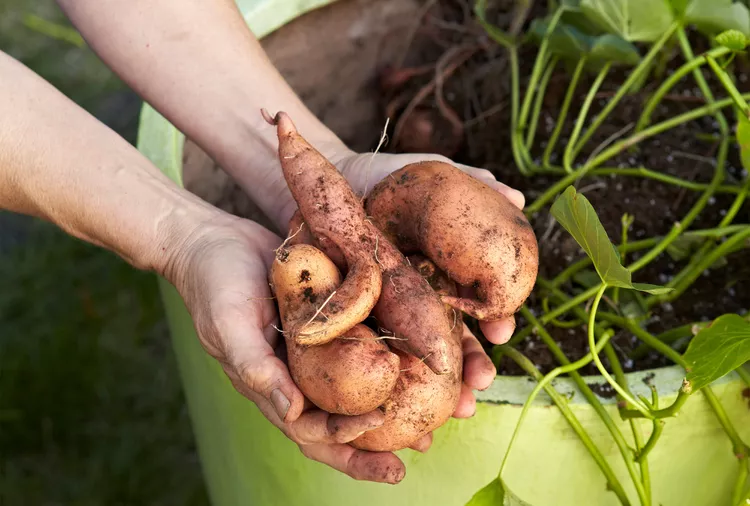10 Best Sweet Potato Companion Plants for Larger Harvests

Weeding, fertilizing, and watering are all essential gardening techniques if you want to grow a large crop of healthy sweet potatoes. But you can enhance the growth of sweet potatoes even further and naturally repel pests like aphids by planting sweet potato companion plants in your garden too. From beans and peas to root veggies, the herbs, vegetables, and flowers listed below all grow well with sweet potatoes and can help you harvest a larger and naturally pest-free crop of sweet potatoes with less hassle and worry.
Alliums
Garlic, shallots, onions, and other alliums are packed with sulfur compounds, which these vegetable plants use as a defense against pests. However, if you grow sweet potatoes and other veggies near your alliums, you can protect your crops from insect damage and naturally deter pests like aphids and rabbits. What’s more, alliums are relatively compact growers and can be easily slipped in between rows of sweet potatoes or used as a pest-repelling garden border.
Legumes
Beans and peas are well-known for their nitrogen-fixing roots, which can actually improve garden soils and boost the growth of nearby plants. If you’re looking for a sweet potato companion plant, legumes are always a good choice, but vining or pole-type legumes are particularly useful. Unlike bush-type legumes, vining beans and peas can be trained to grow up trellises to save space, reduce plant competition, and provide light shade for sweet potatoes as they grow.
Dill
Dill is another versatile companion plant that grows well with many vegetables, as well as flowers and other herbs. Relatively small in size, dill can be planted in between sweet potatoes or grown along the edge of container gardens to provide veggies with a bit of pest protection. Dill flowers are particularly attractive to beneficial insects like hoverflies and parasitic wasps, so if you want to deter the most pests, allow these edible plants to bolt.
Marigolds
With their golden-yellow flowers and fern-like leaves, marigolds have a lot of aesthetic charm, and they can be used to spruce up garden beds with a bit of extra color. However, marigold flowers are more than just attractive garden accents. They also make effective trap crops or deterrents against a wide range of pests, and French or African marigolds are particularly helpful against nematodes, which often damage sweet potato roots.
Root Vegetables
Many root veggies grow well with sweet potatoes, and they have similar care needs, which can streamline your organic gardening chores. Carrots and beets break up tough soils and make it easier for sweet potatoes to grow, while radishes can lure flea beetles away from your main crops and keep sweet potato greens looking pristine. That said, standard potatoes and sweet potatoes can be prone to the same pests and diseases, so it’s best to keep these two crops away from each other in the garden.
Summer Savory
Fragrant herbs of all sorts are excellent companion plants for pest control, but when it comes to sweet potato companion plants, summer savory is especially handy. This fragrant herb can attract beneficial insects with its summertime blooms, but it’s also known to deter sweet potato weevils, which infamously riddle sweet potato tubers with holes. Just keep in mind that unlike winter savory, summer savory is an annual herb and will need to be replanted every year.
Yarrow
Yarrow is most at home in flower gardens, but you can grow it in vegetable beds for its pest repelling properties too. Pollinators can’t resist yarrow’s nectar-rich blooms, but this perennial plant is also good for attracting beneficial insects, like lacewings, ladybugs, and hoverflies. Once they arrive in your garden, those “good guy” insects will feed on aphids and other sweet potato pests and help safeguard your sweet potato crop.
Clover
Many gardeners strive to keep clover plants out of the garden, but if you’re struggling with wireworm problems, clover plants may actually be good to have around. Studies have found that using clover cover crops as part of your crop rotation cycle can actually reduce wireworm populations and protect root veggies. You can also control wireworms by inviting birds into your garden or moving vulnerable crops, like sweet potatoes, into grow bags.
Thyme
Thyme and sweet potatoes pair well together in the kitchen, but they also make fantastic plant partners in the garden. This strong-smelling herb can be used to repel a wide variety of pests, but thyme flowers are also highly attractive to beneficial insects and pollinators as well. For even more benefits, try growing creeping thyme as a groundcover in your veggie garden to insulate the soil and keep weeds at bay.
Sweet Alyssum
Like yarrow, sweet alyssum flowers are irresistible to beneficial insects, and growing this flowering annual near veggie crops can keep culinary gardens pest-free. Thanks to its compact size, sweet alyssum fits right into planters and raised beds alike, but it can also hold its own in larger vegetable gardens. If you want sweet alyssum plants to bloom more prolifically, cut the plants back a bit after their first flowering and leave flowerheads intact at the end of the season to encourage plants to self sow.